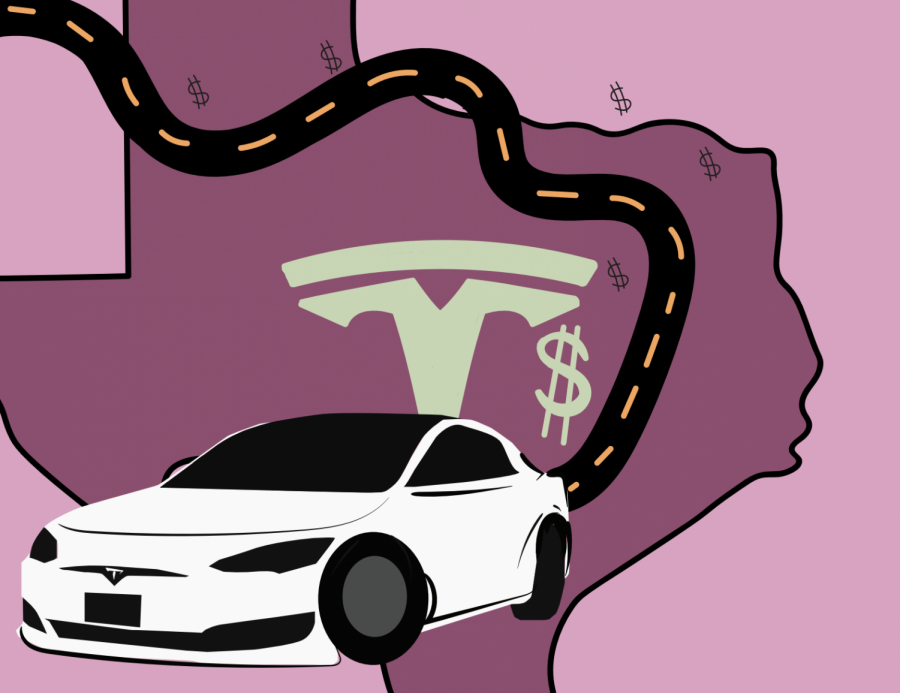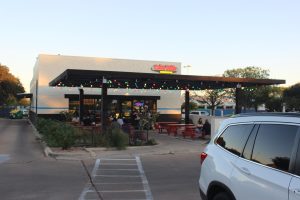Tesla’s gigafactory brings Austin economic opportunity
A link to the company’s job postings currently shows over 350 open positions in Austin, TX. At 10,000 employees, this would place Tesla near the top of the list of Austin’s largest employers, according to 2018 Chamber of Commerce figures.
December 2, 2021
On October 7, Elon Musk announced that Tesla would bring its headquarters to Austin, along with the already-announced Gigafactory. The move was not totally surprising given the public battle Musk has been waging with Alameda County (CA) over COVID-19 related shutdowns and restrictions. The Gigafactory will produce the Tesla Semi, Cybertruck, Model 3 and Model Y. It is expected that the factory will bring over 10,000 jobs to central Texas.
I believe that this new move could be game-changing for residents. Austin has long been home to many major innovative companies such as Google, Apple and Dell, that already boast a presence in the city. Tesla’s move will bring greater opportunity to the capital of the Lone Star state such as new jobs, green energy and additional services pushing positive attention towards the city.
Elon Musk tweeted in March 2021 that “Over 10,000 people are needed for Giga Texas just through 2022!” This represents double the original 5,000 jobs originally promised, as Tesla appears to be taking advantage of the vast talent pool that Austin has to offer.
A link to the company’s job postings currently shows over 350 open positions in Austin, TX. At 10,000 employees, this would place Tesla near the top of the list of Austin’s largest employers, according to 2018 Chamber of Commerce figures. Given the enormity of Tesla’s operations in Austin, their suppliers are anticipated to have a greater presence in the area as well, bringing additional jobs to the city’s economy. For example: suppliers such as Plastikon and Simon North American have both indicated plans to open facilities in nearby Kyle, TX.
Along with thousands of job openings for Tesla, the East Austin area in general will be able to receive more opportunities and services. With Tesla bringing more activity and attention to the East side of Austin, the people who live there can use that attention to their advantage, something they haven’t been able to do before.
The Del Valle school district that covers much of East and Southeast Austin is expected to benefit greatly from the tax revenue that Tesla’s factory will bring. The area is also expected to benefit from the housing, stores, and medical facilities that will be attracted by the employee growth and demand. Tesla has also indicated that it will seek to partner with local high schools, colleges, and trade groups. The company will also be accepting applicants without college degrees.
Tesla’s move will also bring an increased focus to the benefits of green energy to Austin and the entire state. The historically fossil fuel driven state will now have a green auto-manufacturer headquartered not far from its state capital. In addition, Tesla is partnering with two real estate companies (Brookfield Asset Management and Dacra) to bring a sustainable residential community to East Austin.
The sustainable features will include solar and battery powered products, with the goal to reduce demand on the electric grid and eventually create an energy-neutral community. The use of renewable energy over traditional fossil fuels will result in less water and air pollution. Renewable also creates lower greenhouse gas emissions. Overall – renewable energy is better for our planet.
While this big change will enhance many important factors in the Austin area, it could also bring along some worrisome problems. With this expensive car company moving into a more rural part of Austin, it could raise the costs of living and life in general.
The median price for a home in Austin is now $549,000 according to Refin, representing a 40% increase over the last two years. Clearly, the demand for housing by people moving to Austin to fill these new jobs will exacerbate the existing affordability problem in Austin.
However, the arrival of Tesla did not cause the current affordability crisis in Austin. Affordable housing has been a challenge in Austin for years, if not decades. For housing to be considered “affordable” – it would typically be defined as a household that spends less than 30% of their monthly income on housing. Austin’s population growth has outpaced the housing market, which has created an expensive housing market.
Our city leaders should expand funding for affordable housing projects and partner with private businesses. In addition, they should also promote private investment in the Strike Fund (managed by nonprofit Affordable Central Texas) to purchase affordable land for later development.
Another solution is for Travis county to expand the homestead tax abatement policy for older adults, preventing increases in property taxes so residents can continue to reside in their current homes. Austin and Travis county should also consider cutting assessments for landlords that offer affordable housing for lower income families.
I consider Tesla’s move to Austin a necessary change that will bring more good to the city. Where better to relocate their headquarters than Austin, the home to many technological innovators. The Gigafactory will not only allow for a green energy filled environment and cars, but also bring in so many new opportunities to follow.










